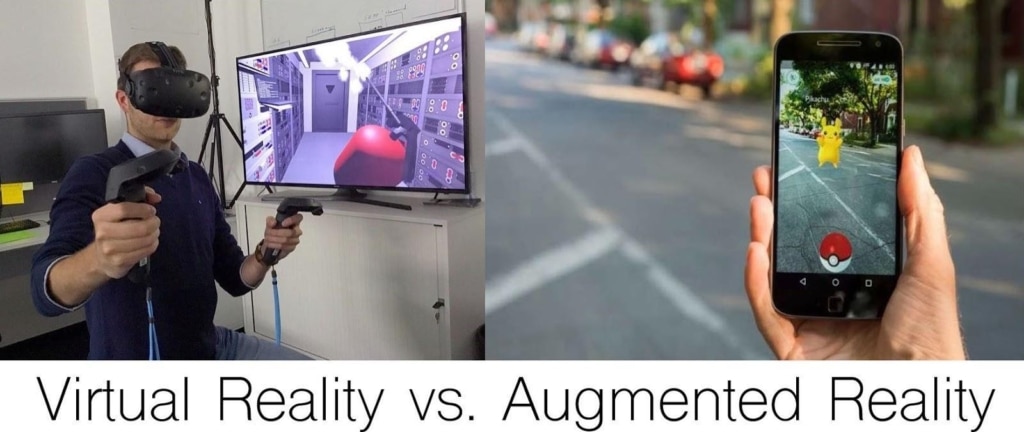You may have been hearing a lot about “AR” recently. This term is up-and-coming, #trending, and a total buzz word. But what exactly is AR? Why should you care about it? In this blog, I will spell out A-U-G-M-E-N-T-E-D R-E-A-L-I-T-Y in the most basic way possible so that everyone, not just the techys, can understand why AR is so disruptive for eCommerce.
Firstly, the differences between augmented and virtual reality must be highlighted because they are often mistook for another. Virtual reality requires a headset for the experience and renders a 3D environment around the user for exploration. But, augmented reality uses the camera to render a 3D model in the user’s own environment. In short words, VR puts you in virtual places while AR augments your current environment by bringing new digital images to you.

Think about what this means for marketing — consumers can actually interact and manipulate an digitized version of your product before they buy it.
TL;DR — we are on the fringe of a customer experience revolution. Before AR, brands and retailers had to rely solely on product photography (or video) and in-store experiences to showcase their goods. Now, technology has progressed to the point where we can blend the physical and digital worlds to provide show-room immersive experiences right in the users’ hands. You may even be using AR without realizing it — anytime you use a Snapchat/Instagram filter or see the first-down line during the Superbowl, it is using augmented reality to ‘paint’ over the physical environment.
Nice-to-have but not need-to-have? Think again.
According to Statista’s market trends, the global AR market will increase over $195 billion dollars in the next five years, from $3.5 billion in 2017 to $198 billion in 2026. Numbers aside, I’d like to draw a parallel to a former eCommerce trend — online ratings and reviews. Let’s rewind 15 years, a simpler time. To find out more about a product that a customer was looking to purchase online, one usually visited a dedicated review site like CNET to read consumer feedback and decide if the purchase is worth the cost. But as market trends developed, online shoppers began expecting this type of feedback directly from the vendor. In comes Amazon, and they create an eCommerce standard that pushes every brand and retailer to host ratings and reviews on their site — now nobody hires a plumber without first looking at consumer feedback.
There is no doubt that we are beginning to see the same type of industry shift with AR as we did with online rating and reviews. With Amazon embracing augmented reality in full force, it is only a matter of time until AR becomes the new eCommerce standard for consumers.
So what does that mean for brands and retailers?
Well you’re in luck. — Vertebrae has spent the last 5 years and millions of dollars figuring this technology out so you don’t have to. Our company started as a virtual reality company creating 3D media for Hollywood’s movie studios. As VR and AR technology began progressing, our founder realized that augmented reality was going to leave VR behind due to its consumer friendliness and broader adoption — VR’s basic requirement of a headset and heavy-weight operating systems would hinder its ease of use for the average consumer. He realized that accessibility was the number one thing keeping AR from widespread adoption, and brain-babied the first web-based augmented reality experience that everyone with a mobile phone could interact with.
Vertebrae’s vision is to enable brands and retailers to host AR experiences directly on their eCommerce site, social sites, and everywhere else they’d like that content syndicated, in the most streamlined way possible. This means creating an AR program with low-weight software that loads almost instantaneously to the browser which shoppers can then add-to-cart without ever having to leave the page.
So when Apple announced AR Kit in 2017, the powder-keg was essentially ignited; augmented reality experiences could now be accessed by anyone with an IPhone. Other major players followed suit; Amazon AR View soon after, Facebook Spark in 2018, and Google Scene Viewer in 2019. AR is now nearly ubiquitously supported across IOS, Android, and social.
How do we get started on an AR strategy?
The first step is to evaluate whether AR is a good use-case for your company. Some verticals have already been proven out as successful use-cases — furniture, luggage, accessories, and auto lend themselves as the most compelling. Once we’ve established a good fit, we can begin planning which product SKUs have the most potential for ROI. Vertebrae has found that SKUs with high price-points but low conversion rates are the best to start with. Then, we use a combination of methods to create the most realistic 3D asset possible — true to size and scale.
It’s our goal to remove every barrier between your company and an AR strategy so we offer to create these 3D assets at the cost of making them (or you can outsource asset creation to a third-party). The Vertebrae CMS platform allows you to manage and deploy these 3D assets wherever your customers engage with the brand (Website, App, Search, Social, Retail Channels, and Ad/Paid Media space.
We are seeing a measurable increase in engagement, conversion, and average order value across verticals. Every single time we implement AR, our clients see a positive ROI. Every single client has renewed and expanded our partnership.
Are you ready for the next great leap forward? Check us out at Vertebrae.com and say hello.
